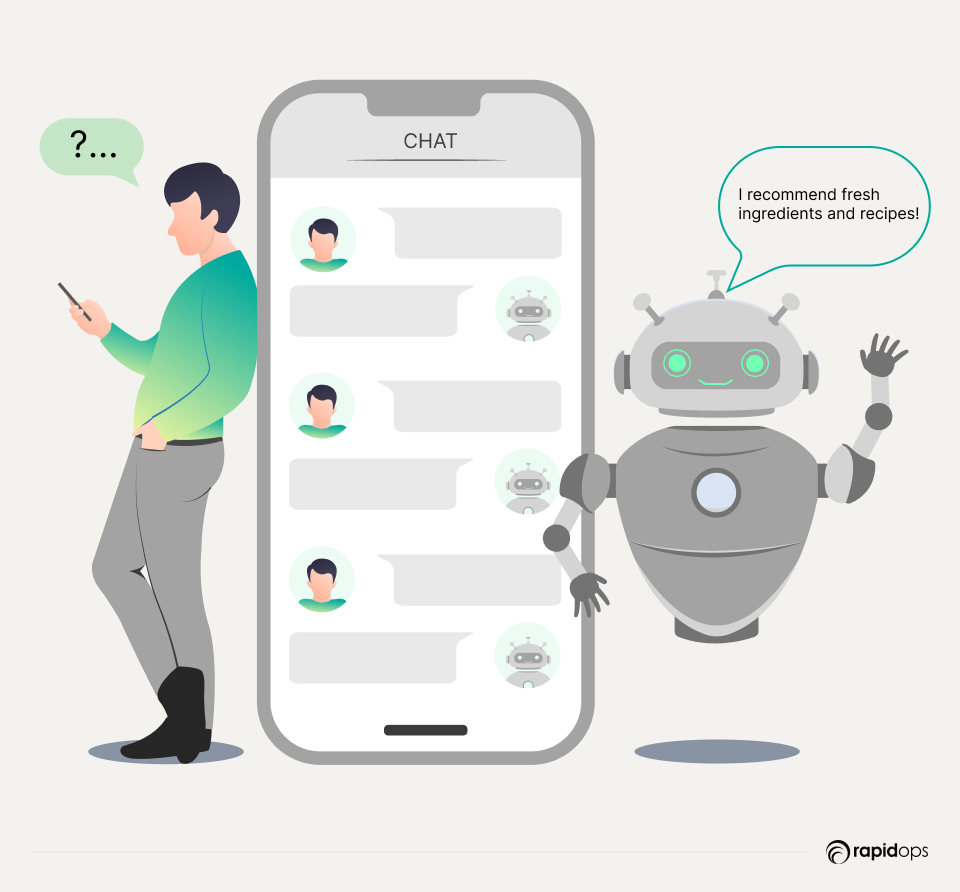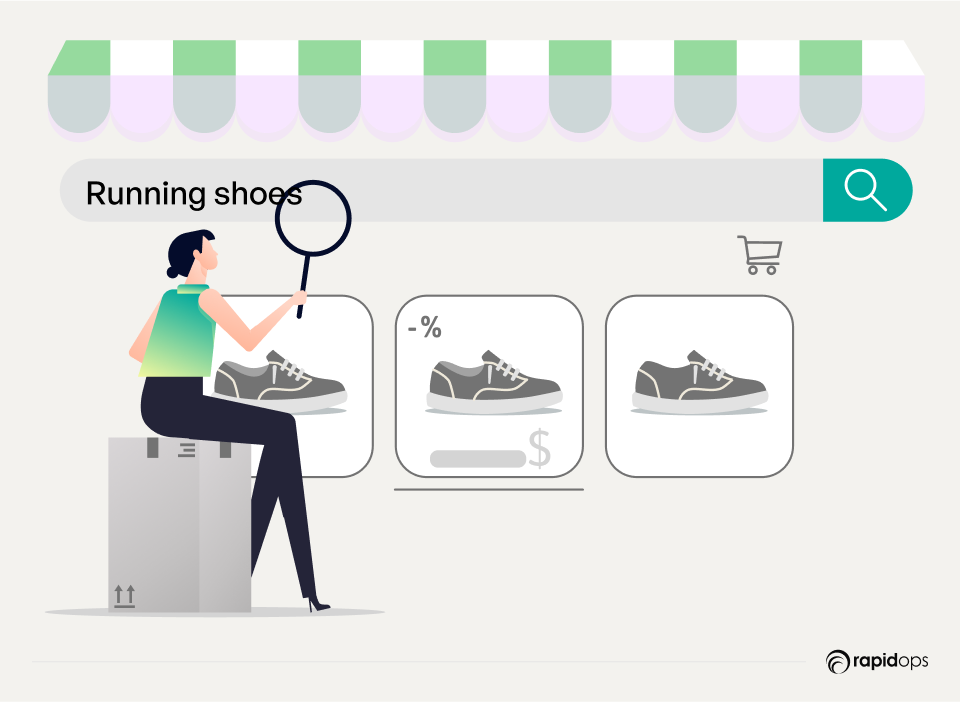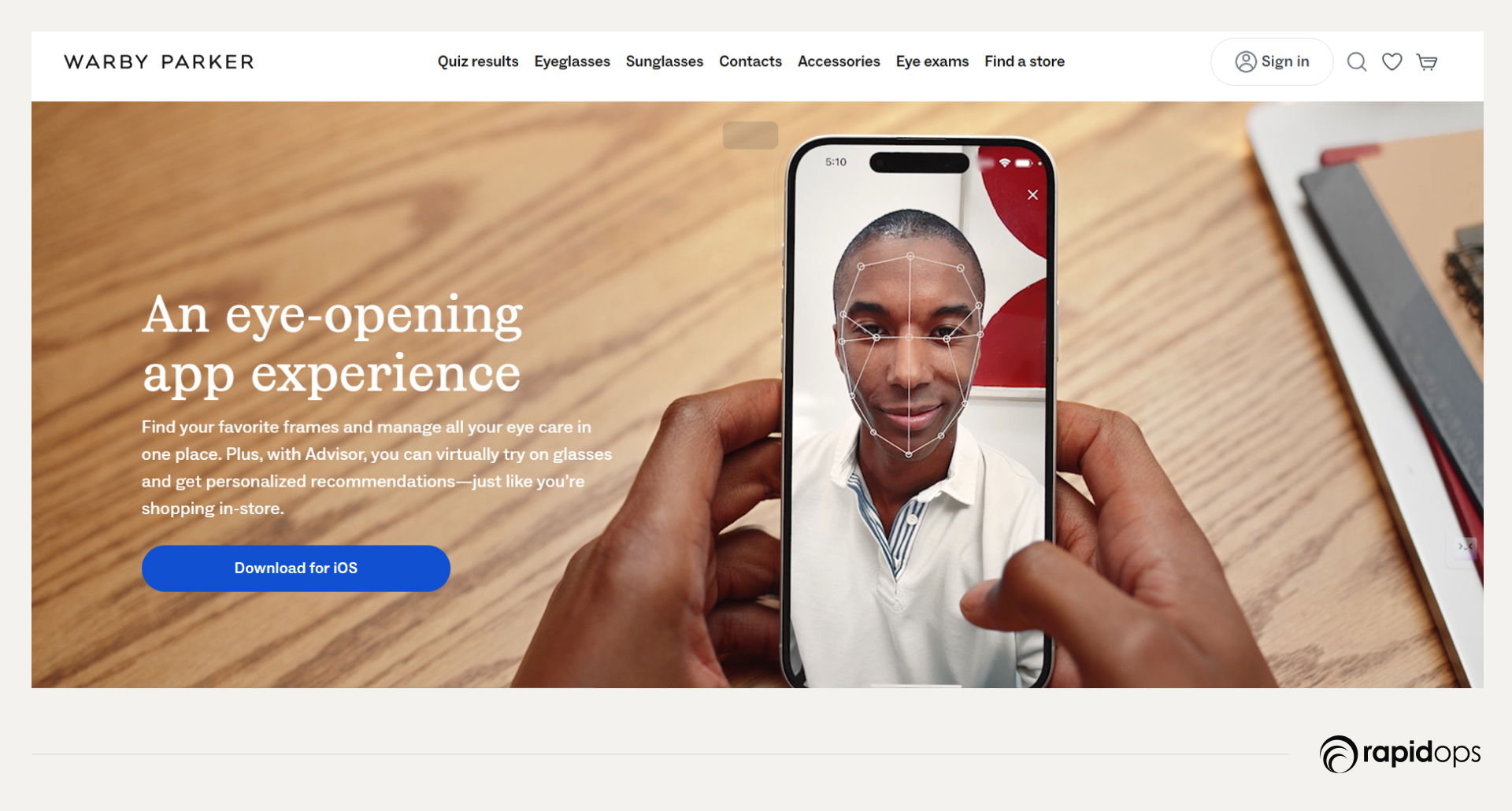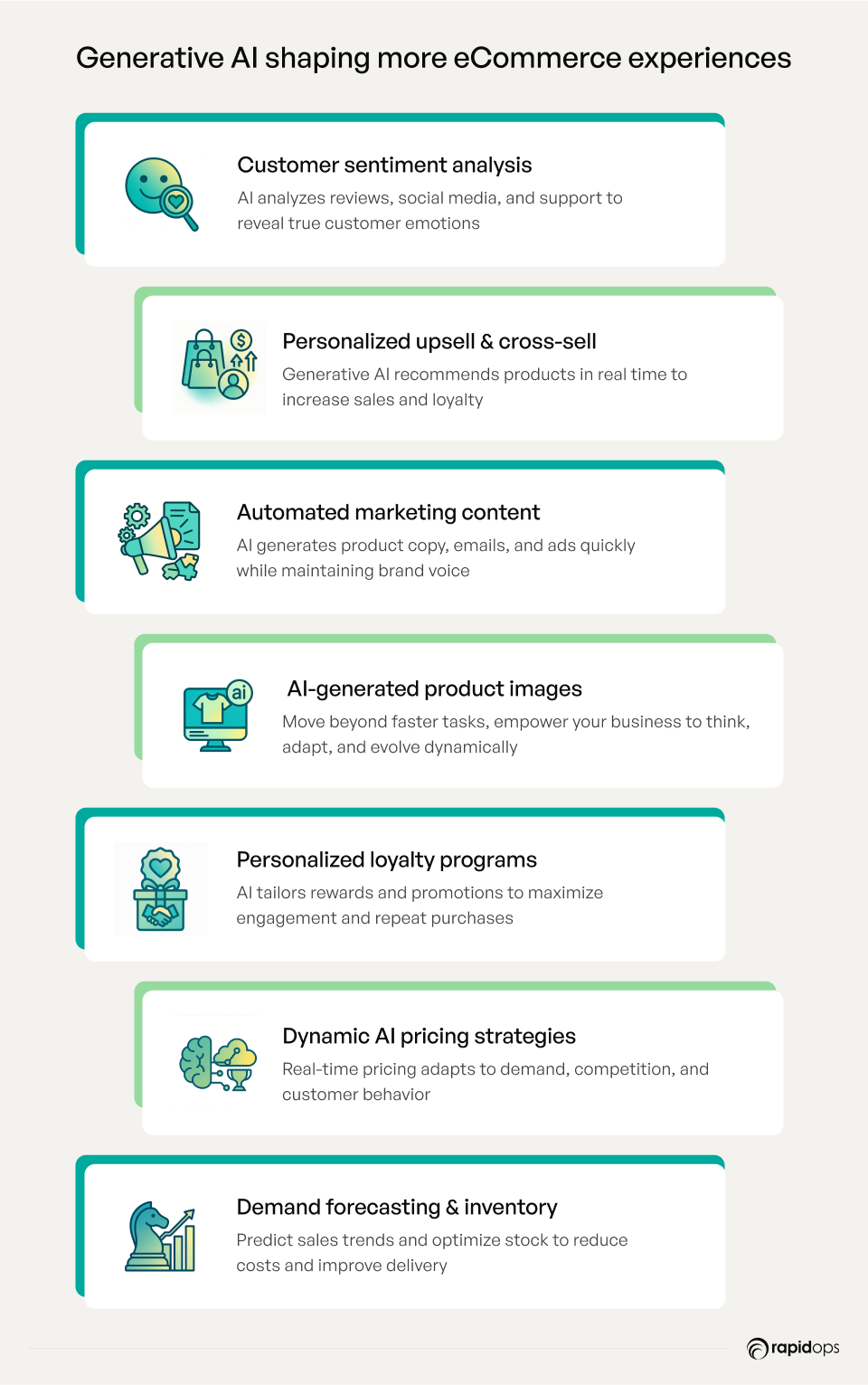Every click, every recommendation, every message matters to today’s customer. They expect experiences that feel personal, effortless, and intuitive, where the brand seems to understand their needs even before they do. Yet many eCommerce enterprises are still striving to meet this expectation. Meanwhile, a few brands have already raised the bar, creating moments that delight, anticipate, and inspire loyalty through Generative AI in eCommerce, driving advanced customer personalization.
Generative AI powers this digital transformation, enabling businesses to decode preferences, anticipate behaviors, and deliver hyper-personalized experiences in real time. From generating product descriptions and marketing content to providing predictive insights and tailored recommendations, generative AI elevates speed, precision, and intelligence across every customer touchpoint.
According to CB Insights (2024), 78% of organizations are exploring AI, yet fewer than 40% have fully integrated it into customer-facing systems. Leading brands are closing this gap with innovative, AI-driven strategies that redefine what’s possible.
For enterprise decision-makers, this is more than technology; it’s a strategic lever for growth, loyalty, and competitive advantage. Generative AI’s capabilities are reshaping customer experiences, operational efficiency, and business outcomes in ways enterprises are just beginning to explore.
This blog shares five groundbreaking case studies where brands harness generative AI in eCommerce to turn insights into action, delight customers, and create measurable business value, offering actionable lessons for enterprises ready to lead the next era of intelligent, hyper-personalized eCommerce.
1. HelloFresh leverages generative AI for conversational commerce

Overview
HelloFresh is a global meal-kit delivery company that provides fresh, pre-portioned ingredients and easy-to-follow recipes to millions of customers worldwide. Founded in 2011, the company operates across multiple countries, aiming to make home cooking simple, convenient, and enjoyable for busy individuals and families. With a focus on sustainability and variety, HelloFresh continually innovates its offerings to meet evolving consumer preferences.
Need
In modern eCommerce, customers expect instant, tailored support. Traditional interfaces, static menus, lengthy FAQs, or delayed human responses often fall short. HelloFresh faced the challenge of scaling real-time, meaningful interactions for millions of subscribers globally while maintaining personalization and operational efficiency. Delivering consistent and engaging support across multiple channels became essential to enhance customer satisfaction, retention, and loyalty.
Solution
Facing this challenge, HelloFresh identified an opportunity to transform customer engagement and streamline support through generative AI in eCommerce. The company strategically implemented AI-powered chatbots across various platforms, including chat, messaging, and voice, to provide intuitive, human-like interactions tailored to each subscriber.
The system was designed to handle routine tasks such as exploring weekly meal options, swapping ingredients, managing subscriptions, and responding to common queries. The chatbots continuously learn from each interaction, adapting to individual preferences in real time to deliver increasingly personalized responses.
By automating repetitive requests, HelloFresh freed human agents to focus on complex, high-value interactions, while continuous monitoring and optimization ensured the AI system improved over time. This approach positioned generative AI as a strategic enabler, allowing HelloFresh to provide scalable, context-aware, and personalized support while maintaining operational efficiency.
Impact
The adoption of generative AI and conversational commerce has delivered measurable benefits for HelloFresh:
- Faster response times: Routine inquiries are resolved instantly, reducing customer wait times.
- Enhanced personalization: Real-time learning ensures tailored meal suggestions, ingredient swaps, and subscription support.
- Higher retention and loyalty: Personalized interactions strengthen engagement and encourage repeat orders.
- Operational efficiency: Automation reduces dependency on call centers, enabling staff to focus on high-value tasks.
- Improved digital brand experience: Human-like conversations replicate in-store guidance, elevating the online journey.
- Scalable support: Chatbots maintain consistent quality across millions of subscribers globally.
- Empowered customers: Personalized, intuitive interactions increase confidence and drive long-term engagement.
HelloFresh leveraged generative AI to scale personalized interactions, enhance efficiency, and foster customer loyalty through seamless conversational commerce.
2. From SaaS platform to generative AI-powered product discovery

Overview
The company is a leading SaaS platform specializing in personalized eCommerce experiences for global brands. Its platform enables retailers to manage digital storefronts, deliver engaging shopping experiences, and scale operations efficiently. With a focus on innovation, real-time personalization, and seamless customer journeys, the company continuously evolves its technology to help brands stay ahead in the rapidly changing digital commerce landscape.
Need
Customers increasingly sought natural, effortless ways to find products, through conversational queries, descriptive language, or images, while brands needed automated tools to deliver personalized recommendations and streamline merchandising. The company faced the challenge of upgrading its existing platform to meet these demands without disrupting ongoing operations, ensuring scalability, real-time personalization, and alignment with brand-specific rules.
Solution
To address these challenges, the company upgraded its platform with a modular, generative AI-powered architecture. They introduced a semantic discovery engine capable of interpreting customer intent beyond literal keywords, learning continuously from browsing behavior and purchase data. Natural language search enabled the system to understand typos, slang, and long-tail queries, while multimodal visual search allowed shoppers to find products using text and image inputs, capturing attributes like color, style, and patterns.
Personalized recommendations were enhanced across categories, leveraging historical behavior, seasonal trends, and inventory insights. On the operational side, AI-driven automation empowered intelligent agents to monitor product performance, dynamically adjusting rankings and promotions with minimal manual intervention.
Finally, real-time personalization ensured that every interaction, search, browsing, or checkout was context-aware, dynamically re-ranking products while respecting brand logic. These upgrades transformed the platform into a flexible, intelligent system, enabling brands to deliver highly relevant, scalable, and engaging product discovery experiences.
Impact
Upgrading the platform with generative AI delivered measurable benefits:
- Enhanced customer engagement: Shoppers experienced faster, more intuitive, and context-aware product discovery.
- Improved personalization: Recommendations were tailored based on browsing history, trends, and inventory insights.
- Reduced manual effort: AI-driven merchandising automation minimized dependency on human intervention.
- Higher satisfaction and loyalty: Customers found products more easily, leading to stronger brand loyalty.
- Scalable architecture: The platform can handle millions of interactions in real time while continuously learning and adapting.
Enhancing the existing SaaS platform with generative AI transformed product discovery into a seamless, automated, and highly personalized journey, enabling brands to meet evolving customer expectations while streamlining operations and driving engagement.
3. Amazon Rufus uses generative AI for personal shopping assistance

Overview
Amazon, the global eCommerce leader, continuously innovates to make online shopping more intuitive and personalized. With millions of products across categories, the company recognized the need to guide customers seamlessly through product discovery, comparison, and decision-making. By leveraging generative AI, Amazon ensures that each interaction is context-aware, cohesive, and tailored to individual preferences, enhancing both convenience and engagement.
Need
Modern shoppers often face decision fatigue due to the overwhelming number of choices online. Traditional search engines and recommendation systems treat each query as an isolated event, creating fragmented experiences. For complex purchases, such as multi-item outfits, home furnishings, or electronics bundles, customers struggled to find relevant options efficiently, leading to abandoned carts and missed revenue. Amazon identified an opportunity to simplify discovery, provide personalized guidance in real-time, and maintain a seamless, engaging experience across categories.
Solution
Recognizing the challenge of decision overload, Amazon decided to enhance its personal shopping experience with Rufus, a generative AI-powered assistant. The company approached this by analyzing customer behavior to identify pain points, defining the capabilities Rufus would need to provide personalized guidance, and integrating the AI assistant into its existing platform.
Rufus was designed to learn user preferences in real-time, interpret natural language queries, and provide contextually relevant recommendations across multiple product categories. The system also highlights complementary products and deals that customers might otherwise overlook, ensuring efficient, intuitive, and human-like interactions. Continuous learning enables Rufus to refine suggestions based on browsing history, past purchases, and evolving user behavior, transforming routine searches into a cohesive, intelligent, and scalable shopping experience.
Impact
The implementation of Rufus delivered measurable benefits:
- Reduced decision fatigue: Shoppers navigate complex purchases effortlessly with AI-guided recommendations.
- Higher conversion rates: Personalized suggestions and complementary product guidance increase order completion.
- Enhanced customer satisfaction: Unified and context-aware interactions feel thoughtful and human-like.
- Increased average order values: Cross-category and complementary recommendations drive additional purchases.
- Operational scalability: Continuous AI support reduces reliance on customer service teams while maintaining quality.
- Strengthened brand loyalty: Seamless, personalized experiences encourage repeat engagement and long-term retention.
Amazon’s integration of generative AI through Rufus demonstrates how companies can transform multi-step online shopping into a seamless, intelligent experience. By framing the solution from customer challenges, strategic decisions, and AI-enabled execution, Amazon elevated personalization, efficiency, and engagement at scale, setting a benchmark for AI-driven eCommerce innovation.
4. Sephora Virtual Artist: Personalized shopping powered by generative AI

Overview
Sephora, a global leader in beauty retail, is transforming the digital shopping experience by delivering hyper-personalized, AI-powered interactions. Through its Virtual Artist platform, the company offers personalized product recommendations, virtual try-ons, and interactive browsing that cater to individual preferences. The goal is to replicate the personalized guidance of in-store shopping while offering a seamless, intuitive, and engaging digital journey.
Need
Online beauty shoppers often face overwhelming choices, leading to decision fatigue and lower engagement. Traditional recommendation systems rely on static rules or past purchases, offering generic suggestions that fail to resonate. Sephora recognized an opportunity to enhance online product discovery by providing real-time, context-aware, and dynamic recommendations that align with customer intent, maintain brand consistency, and scale across millions of interactions.
Solution
Sephora addressed this opportunity by enhancing its existing digital platform with generative AI-powered Virtual Artist features. The company implemented a system that learns and adapts to individual users, analyzing virtual try-ons, browsing behavior, and customer profiles to generate tailored suggestions. When a customer experiments with a lipstick shade, skincare product, or other beauty item, the platform recommends complementary products, alternative shades, or trending items. These recommendations are delivered seamlessly through interactive product cards in the app, making discovery effortless and intuitive. Continuous learning allows the AI to refine its suggestions over time, ensuring relevance, timeliness, and alignment with shopper intent, while transforming online shopping into a personalized, context-aware, and highly engaging experience.
Impact
Sephora’s generative AI personalization delivers measurable benefits:
- Increased engagement: Customers explore more products and spend longer interacting with the platform.
- Higher conversion rates: Tailored recommendations drive more purchases.
- Boosted average order value: Complementary and alternative product suggestions increase basket sizes.
- Improved customer satisfaction: Personalized, intuitive experiences reduce decision fatigue and enhance confidence.
- Stronger loyalty: Shoppers feel understood, fostering repeat engagement and brand affinity.
- Scalable personalization: AI enables consistent, high-quality recommendations for millions of users globally.
By embedding generative AI into the Virtual Artist platform, Sephora has transformed digital shopping into an interactive, personalized, and revenue-generating experience. The approach demonstrates how aligning AI technology with customer intent can enhance engagement, conversion, and loyalty while delivering a seamless, human-like digital journey.
5. Warby Parker: Generative AI-powered virtual eyewear try-on

Overview
Warby Parker is a leading direct-to-consumer eyewear brand known for combining style, affordability, and convenience. Founded in 2010, the company disrupted the traditional eyewear industry by offering high-quality frames online and in stores. With a commitment to customer-centric innovation, Warby Parker continuously explores technology-driven solutions to enhance the shopping experience, reduce friction, and deliver personalized, accessible eyewear to millions of customers worldwide.
Challenge
Customers shopping for eyewear online often face uncertainty about fit, style, and appearance, which can lead to hesitation, abandoned carts, and high return rates. Traditional eCommerce platforms lacked the ability to visualize frames on individual faces or provide tailored recommendations. Warby Parker recognized the opportunity to replicate the in-store experience digitally, offering personalized guidance at scale, reducing purchase friction, and enhancing both satisfaction and operational efficiency.
Solution
To address this, Warby Parker integrated a Generative AI-powered virtual try-on system into its app. The system maps facial features in real time using a smartphone camera, overlaying frames for a realistic preview. Generative AI analyzes a user's face shape, style preferences, past interactions, and behavior to generate personalized frame recommendations, effectively acting as a digital stylist.
This approach enables customers to explore frames, experiment with different styles, and receive tailored suggestions seamlessly within the app. By combining AI and augmented reality, the company transformed online eyewear shopping into an intuitive, interactive, and highly personalized experience while maintaining brand consistency and scalability.
Impact
Increased customer confidence: Shoppers can visualize frames accurately, reducing hesitation and supporting informed purchase decisions.
- Higher conversion rates: Personalized recommendations and realistic previews drive purchases and reduce cart abandonment.
- Reduced returns: Better fit visualization lowers returns, improving operational efficiency and profitability.
- Enhanced customer engagement and loyalty: Tailored experiences create a sense of individual attention, strengthening brand trust.
- Scalable, technology-driven solution: Generative AI enables consistent, high-quality virtual assistance across millions of users without overburdening customer support.
Warby Parker’s implementation of Generative AI demonstrates how digital innovation can replicate and enhance in-store experiences online. By leveraging AI-driven personalization, the company delivers immersive, efficient, and customer-centric shopping experiences that drive measurable business results while elevating brand loyalty.
How generative AI is shaping more eCommerce experiences
Generative AI in eCommerce is transforming how businesses operate, engage customers, and maximize revenue. Its applications extend far beyond personalization and product discovery, impacting marketing, pricing, visual content, loyalty, inventory management, and customer insights. By leveraging generative AI, companies can automate complex tasks, make data-driven decisions, and deliver hyper-relevant experiences that delight shoppers while driving measurable business outcomes.

1. Generative AI for customer sentiment and feedback analysis
Customer feedback is often scattered across reviews, social media, and support channels, making it challenging for brands to extract actionable insights. Generative AI aggregates and analyzes this data at scale, detecting sentiment, context, and subtleties such as sarcasm or irony. Advanced models interpret complex emotions 65–75% of the time, significantly outperforming traditional methods and providing a more nuanced understanding of customer sentiment.
By leveraging these insights, businesses can turn unstructured feedback into actionable intelligence. 80% of buyers are more likely to purchase when experiences reflect an understanding of their emotions, and AI-driven monitoring enables 25% faster responses to public relations issues. Brands can optimize marketing campaigns, enhance product development, improve customer service, and strengthen loyalty, resulting in higher satisfaction, reduced churn, and measurable business impact—demonstrating the value of Generative AI in eCommerce.
2. Hyper-personalized upselling and cross-selling engines
In eCommerce, shoppers often add items to their cart without realizing complementary products that could enhance their purchase. Generative AI addresses this by analyzing cart contents, browsing behavior, and individual preferences in real time to deliver highly personalized upselling and cross-selling suggestions. These generative AI-driven recommendations replicate the guidance of an in-store associate, providing a seamless, intuitive shopping experience.
For instance, if a customer selects a few skincare products, the AI might suggest related items to complete the routine, increasing convenience and satisfaction. Platforms like Rep AI, integrated with Shopify, have demonstrated measurable results; businesses report up to a 67% increase in sales when using digital recommendation bots. By combining personalization with real-time insights, Generative AI not only boosts average order value but also strengthens brand trust and customer loyalty.
3. Automated content generation for scalable marketing
Producing consistent, high-quality marketing content manually can be slow and resource-intensive. Generative AI in eCommerce transforms this process by automatically generating product descriptions, email campaigns, social media posts, and advertisements tailored to each audience segment.
Platforms like Jasper leverage AI to create SEO-optimized, personalized copy while maintaining brand voice, enabling teams to launch campaigns faster and at scale. Research shows that businesses using AI-generated content can reduce production time by up to 50%, while increasing engagement and conversion rates. Generative AI not only boosts efficiency but also empowers marketing teams to focus on strategy and creativity, driving measurable business impact and ensuring timely, relevant messaging for every customer.
4. Product image generation powered by generative AI
High-quality visual content is a key driver of eCommerce conversion, yet traditional photography can be costly and time-consuming. Generative AI in eCommerce leverages techniques like Generative Adversarial Networks (GANs) to create realistic, on-demand product images.
Brands such as IKEA use AI-generated visuals to showcase product variations, update catalogs, or visualize future designs, enabling rapid and flexible content creation. Research indicates that visually appealing images can increase online sales by up to 40%, highlighting the importance of effective visuals in driving engagement. By reducing dependency on traditional photography, Generative AI allows retailers to maintain consistent branding, accelerate content production, and deliver immersive shopping experiences that capture attention and boost customer confidence.
5. Personalized loyalty and rewards programs
Generative AI in eCommerce empowers brands to create highly targeted loyalty initiatives by analyzing customer transaction history, engagement patterns, and lifetime value. AI-driven programs automatically generate personalized rewards and promotions, delivered at the optimal time to maximize impact.
For instance, HelloFresh leverages predictive segmentation to tailor recommendations and incentives based on individual behavior, increasing repeat purchases and overall customer lifetime value. Businesses using AI-powered loyalty systems report up to 30% higher repeat purchase rates and improved engagement, demonstrating the measurable impact of personalized incentives.
By delivering relevant rewards that resonate with each customer, generative AI strengthens brand advocacy, fosters long-term loyalty, and ensures retention strategies are both scalable and data-driven.
6. AI-powered dynamic pricing strategies
Static pricing can limit competitiveness, but generative AI in eCommerce empowers retailers to implement real-time, context-aware pricing models. By analyzing competitor activity, seasonal demand fluctuations, and customer behavior, AI systems recommend optimal prices for individual segments, ensuring maximum revenue and market responsiveness.
For example, Walmart’s AI-driven pricing experiments have demonstrated measurable increases in conversion rates while maintaining profit margins, showing how adaptive pricing can respond instantly to changing demand conditions. Businesses using AI-based pricing report faster reaction times to market shifts and up to a 10–15% improvement in revenue efficiency compared to traditional pricing methods.
Generative AI allows retailers to dynamically adjust prices without manual intervention, ensuring competitiveness, profitability, and customer satisfaction while unlocking smarter, data-driven pricing strategies that scale across large product assortments.
7. Intelligent demand forecasting and inventory optimization
Generative AI is revolutionizing eCommerce by enabling precise AI-driven demand forecasting and smarter inventory management. By analyzing historical sales data, market trends, seasonal patterns, and external factors, AI-driven systems predict demand accurately, helping businesses reduce costly stockouts and overstock.
For example, Amazon leverages generative AI to optimize inventory by location, factoring in variables like sales events, weather, and customer behavior, ensuring product availability and faster delivery. Companies that use AI-powered forecasting report a 25% reduction in inventory costs and a 30% improvement in customer satisfaction. This approach boosts operational efficiency and strengthens competitiveness in a dynamic retail environment.
Making generative AI work for your business
You’ve seen how generative AI is reshaping eCommerce, enabling hyper-personalized product recommendations, automated content, smarter inventory management, and deeper customer engagement. But technology alone doesn’t create impact. Real transformation comes from solutions that are thoughtfully designed, aligned with your business goals, and built to scale.
At Rapidops, we help businesses harness the full potential of generative AI. With deep expertise in AI strategy, data engineering, and enterprise-scale implementation, we design solutions that directly address your business needs. From enhancing product discovery and automating marketing content to refining pricing strategies, our hands-on approach ensures generative AI development services drive measurable results, elevates customer experiences, and creates meaningful growth.
Want to see how generative AI can transform your business? Schedule a session with our experts to explore tailored strategies and high-impact use cases ready for implementation.
Frequently Asked Questions
How can businesses use generative AI in eCommerce?
Businesses can leverage generative AI in eCommerce to automate content creation, enhance product recommendations, and deliver hyper-personalized customer experiences. By analyzing user behavior, purchase history, and preferences, generative AI generates tailored marketing campaigns, product descriptions, and promotional content. Retailers can also use it for dynamic pricing, merchandising strategies, and personalized email campaigns. Implementing generative AI in eCommerce helps companies scale operations efficiently while maintaining consistent quality and relevance across customer touchpoints.
How does generative AI work and generate results?
Generative AI in eCommerce relies on advanced machine learning models, including deep learning architectures like transformers and neural networks. These models analyze historical data, product attributes, and customer interactions to generate new outputs, such as personalized recommendations or content. The system learns patterns and predicts what content, products, or offers are likely to resonate with each customer, resulting in higher engagement, conversion rates, and improved customer satisfaction.
What challenges or limitations does generative AI face in eCommerce?
While generative AI offers transformative potential, it faces challenges such as data quality issues, integration complexity, and maintaining brand consistency. Poor or incomplete data can lead to inaccurate recommendations, while complex eCommerce systems may require careful integration. Additionally, AI-generated content must align with brand voice to avoid customer confusion. Addressing these challenges requires careful planning, skilled teams, and continuous monitoring of AI outputs.
Which technologies are crucial for implementing generative AI in eCommerce?
Key technologies for generative AI in eCommerce include natural language processing (NLP), machine learning frameworks (like TensorFlow or PyTorch), cloud computing platforms, and robust data management systems. APIs and integrations with CRM, ERP, and eCommerce platforms are also critical. These technologies collectively enable scalable AI implementations, seamless data processing, and accurate AI-driven insights that enhance overall business operations.
What generative AI is most used for in online retail?
In online retail, generative AI is most used for personalized product recommendations, automated content creation, pricing optimization, and customer support through AI chatbots. Retailers also leverage it for predictive analytics, campaign optimization, and inventory forecasting. By applying generative AI in eCommerce, businesses can increase engagement, reduce operational workload, and improve the overall shopping experience for customers.
How is generative AI shaping the future of online shopping?
Generative AI in eCommerce is redefining online shopping by enabling hyper-personalized experiences, intelligent search results, and adaptive marketing strategies. Customers now receive product suggestions and content tailored to their preferences in real time. Over time, generative AI will drive fully automated, data-driven eCommerce environments where every interaction from browsing to checkout is optimized for engagement and conversion.
Can generative AI help reduce operational costs in eCommerce?
Yes, generative AI reduces operational costs by automating repetitive tasks such as content creation, customer support, and inventory management. It minimizes human intervention, improves accuracy, and speeds up workflows. By integrating generative AI in eCommerce, businesses can reallocate resources to strategic initiatives, reduce overhead, and achieve scalable operations without compromising customer experience.
What technical expertise is needed to implement generative AI effectively?
Implementing generative AI in eCommerce requires expertise in machine learning, deep learning, data engineering, and cloud computing. Teams should be skilled in natural language processing, AI model training, API integration, and data analytics. Additionally, business insight is crucial to align AI solutions with eCommerce goals, ensuring outputs are relevant, practical, and generate measurable business impact.
How do businesses choose between off-the-shelf AI tools and custom solutions?
Choosing between off-the-shelf generative AI tools and custom solutions depends on business size, budget, and goals. Off-the-shelf tools provide faster deployment and pre-trained models but may lack flexibility for unique workflows. Custom solutions provide tailored AI models optimized for specific e-commerce requirements, enabling deeper personalization, seamless integration with existing systems, and strategic scalability. Evaluating ROI, integration complexity, and long-term objectives is critical.
What types of data are required for generative AI in eCommerce?
Generative AI in eCommerce requires structured and unstructured data, including customer demographics, purchase history, browsing behavior, product catalogs, and marketing content. High-quality, comprehensive datasets enable AI models to generate accurate predictions, personalized recommendations, and engaging content. Continuous data collection and validation are essential to ensure the AI evolves with changing consumer trends.
Can generative AI identify emerging market trends for business strategy?
Yes, generative AI analyzes large volumes of data to detect patterns, customer preferences, and emerging trends in real time. Retailers can leverage these insights to inform product launches, promotional campaigns, and inventory planning. By identifying trends early, businesses gain a competitive advantage, optimize offerings, and stay ahead in rapidly evolving eCommerce markets.
How do eCommerce companies integrate generative AI with existing platforms?
Integrating generative AI in eCommerce involves connecting AI models with existing platforms such as CRM, ERP, and content management systems through APIs. This ensures seamless data flow, real-time personalization, and synchronized marketing campaigns. Integration also requires mapping business workflows, validating AI outputs, and monitoring performance to ensure the solution complements existing operations effectively.
What are the common pitfalls in scaling generative AI solutions?
Common pitfalls include poor data quality, insufficient technical expertise, lack of alignment with business goals, and over-reliance on automation without oversight. Scalability challenges can also arise from system integration issues and underestimating computational resource requirements. To avoid these pitfalls, businesses should adopt a phased implementation, continuously monitor results, and maintain alignment between AI outputs and strategic objectives.

Rahul Chaudhary
Content Writer
With 5 years of experience in AI, software, and digital transformation, I’m passionate about making complex concepts easy to understand and apply. I create content that speaks to business leaders, offering practical, data-driven solutions that help you tackle real challenges and make informed decisions that drive growth.
What’s Inside
- 1. HelloFresh leverages generative AI for conversational commerce
- 2. From SaaS platform to generative AI-powered product discovery
- 3. Amazon Rufus uses generative AI for personal shopping assistance
- 4. Sephora Virtual Artist: Personalized shopping powered by generative AI
- 5. Warby Parker: Generative AI-powered virtual eyewear try-on
- How generative AI is shaping more eCommerce experiences
- Making generative AI work for your business

Let’s build the next big thing!
Share your ideas and vision with us to explore your digital opportunities
Similar Stories
- AI
- 4 Mins
- September 2022

- AI
- 9 Mins
- January 2023


Receive articles like this in your mailbox
Sign up to get weekly insights & inspiration in your inbox.

